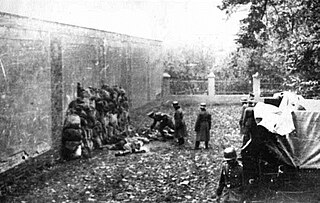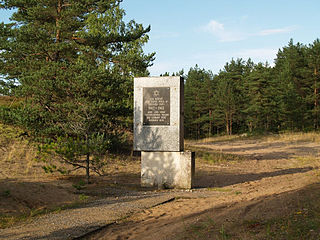 W
WThe Holocaust in Estonia refers to the Nazi crimes during the occupation of Estonia by Nazi Germany. Prior to the war, there were approximately 4,300 Estonian Jews. After the 1940 Soviet occupation, about 10% of the Jewish population was deported to Siberia, along with other Estonians. About 75% of Estonian Jews, aware of the fate that awaited them from Nazi Germany, escaped to the Soviet Union; virtually all of those who remained were killed by Einsatzgruppe A and local collaborators before the end of 1941. Roma people of Estonia were also murdered and enslaved by the Nazi occupiers and their collaborators. The Nazis and their allies also killed around 6,000 ethnic Estonians and 1,000 ethnic Russians who were accused of being communist sympathizers or the relatives of communist sympathizers. In addition around 15,000 Soviet prisoners-of-war and Jews from other parts of Europe were killed in Estonia during the German occupation.
 W
WEinsatzgruppen were Schutzstaffel (SS) paramilitary death squads of Nazi Germany that were responsible for mass killings, primarily by shooting, during World War II (1939–1945) in German-occupied Europe. The Einsatzgruppen had an integral role in the implementation of the so-called "Final Solution to the Jewish Question" in territories conquered by Nazi Germany, and were involved in the murder of much of the intelligentsia and cultural elite of Poland, including members of the Catholic priesthood. Almost all of the people they killed were civilians, beginning with the intelligentsia and swiftly progressing to Soviet political commissars, Jews, and Romani people, as well as actual or alleged partisans throughout Eastern Europe.
 W
WThe Einsatzgruppen Operational Situation Reports (OSRs), or ERM for the German: Die Ereignismeldung UdSSR, were dispatches of the Nazi death squads (Einsatzgruppen), which documented the progress of the Holocaust behind the German-Soviet frontier in the course of Operation Barbarossa, during World War II. The extant reports were sent between June 1941 and April 1942 to the Chief of the Security Police and the SD in Berlin, from the occupied eastern territories including modern-day Poland, Belarus, Ukraine, Russia, Moldova, and the Baltic Countries. During the Nuremberg War Crimes Trials the originals were grouped according to year and month and catalogued using a consecutive numbering system, as listed in the below table. The original photostats are held at the National Archives in Washington D.C..
 W
WDuring World War II, the Nazi German Einsatzkommandos were a sub-group of the Einsatzgruppen – up to 3,000 men total – usually composed of 500–1,000 functionaries of the SS and Gestapo, whose mission was to exterminate Jews, Polish intellectuals, Romani, and communists in the captured territories often far behind the advancing German front. Einsatzkommandos, along with Sonderkommandos, were responsible for the systematic killing of Jews during the aftermath of Operation Barbarossa, the invasion of the Soviet Union. After the war several commanders were tried in the Einsatzgruppen trial, convicted, and executed.
 W
WThe Generalplan Ost, abbreviated GPO, was the Nazi German government's plan for the genocide and ethnic cleansing on a vast scale, and colonization of Central and Eastern Europe by Germans. It was to be undertaken in territories occupied by Germany during World War II. The plan was attempted during the war, resulting indirectly and directly in the deaths of millions by shootings, starvation, disease, extermination through labor, and genocide. But its full implementation was not considered practicable during the major military operations, and was prevented by Germany's defeat.
 W
WAfter a long history of being ruled over by others, Estonia gained their independence in 1918 after the collapse of the Russian Empire. However, in 1940, in the wake of the Molotov–Ribbentrop Pact of 1939, the Soviet Union occupied Estonia and annexed the country.
 W
WKalevi-Liiva are sand dunes in Jõelähtme Parish in Harju County, Estonia. The site is located near the Baltic coast, north of the Jägala village and the former Jägala concentration camp. It is best known as the execution site of at least 6,000 Jewish and Roma Holocaust victims.
 W
WAlgoth Niska was a Finnish bootlegger, footballer and adventurer.
 W
WThe Omakaitse was a militia organisation in Estonia. It was founded in 1917 following the Russian Revolution. On the eve of the Occupation of Estonia by the German Empire the Omakaitse units took over major towns in the country allowing the Salvation Committee of the Estonian Provincial Assembly to proclaim the independence of Estonia. After the German Occupation the Omakaitse became outlawed.
 W
WSonderaktion 1005, also called Aktion 1005, or Enterdungsaktion, began in May 1942 during World War II to hide any evidence that people had been murdered by Nazi Germany in German-occupied Poland and Soviet Union. The project, which was conducted in secrecy from 1942 to 1944, focused on concealing evidence of mass murder at the Operation Reinhard killing centres, as well as at other sites. Groups of Sonderkommando prisoners, officially called Leichenkommandos, were used to exhume mass graves and burn the bodies; inmates were often put in chains to prevent them from escaping.